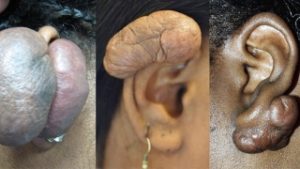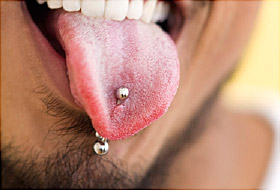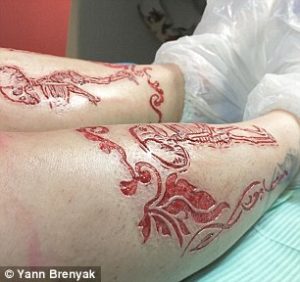Tattoos, piercings, and scarification have been around for thousands of years and are seen by many as a way to express oneself. They may also be used culturally to show status. However, it is necessary to understand the health risks associated with these types of body modifications. This article isn’t to talk you out of getting a tattoo or piercing, but instead, to provide you with information that may be helpful in guiding your decision.
TATTOOS

According to the Pew Research Center, in 2010, 38% of 18-29 year olds had at least one tattoo (AAP, 2017). During the tattooing procedure, tattoo artists use a mechanized needle that rapidly and repeatedly drives the needle in and out of the skin, usually 80 to 150 times a second. With each puncture, the needle injects dyes and pigments into the dermis (inner) layer of the skin. While most tattoo pigments are regulated by the Food and Drug Administration (FDA), many still contain trace amounts of metal salts which can be potentially carcinogenic (cancer-causing) to humans. Tattoos can also cause a variety of health issues, including allergic reactions and blood-borne infections such as Hepatitis B, Hepatitis C, and Tetanus.
PIERCINGS

Did you know that 23% of young adults had piercing in areas other than their earlobes(AAP, 2017)? While piercings may look cute or cool to some, it is important to know that they carry health risks, as well, especially if not treated properly. Some complications of piercings include increased risk of bacterial infection, allergic reactions, bleeding, hematoma formation, keloid formation, and cyst formation.

Oral piercings usually involve making a small hole on your tongue, uvula, lip, or cheek to wear jewelry. Infections are more common with oral piercings because the mouth contains a lot of bacteria that can cause the area to swell or become infected. It can also lead to damage to your gums, teeth, and fillings. Not only can your tongue swell making it harder to breathe, but also you have to be extra careful not to chip a tooth while you sleep, eat, or chew. Mouth piercings could also potentially lead to gum disease, Hepatitis B, Hepatitis C, uncontrolled bleeding, and long-term infection.
SCARIFICATION
Scarification is the process of branding, burning or cutting pictures, words or images into the skin. Practitioners often use methods that will enhance the formation of scars. This includes scraping off scabs or irritating  wounds with materials such as citrus juice, toothpaste, or iodine. Some methods of scarification include cutting with a scalpel, laser branding, hot and cold branding (with liquid nitrogen), thermocautery, and electrocautery. Traditionally, cultures will pack the wound with materials like clay or ash, which can cause hypertrophic scars. Hypertrophic scars are a result of excess deposits of collagen forming at the site of injury (i.e., cuts, burns, pimples). However, scarification doesn’t always go according to plan. Keloids (thick, raised scars) are a known complications and can form, especially in individuals with a family history of keloids.
wounds with materials such as citrus juice, toothpaste, or iodine. Some methods of scarification include cutting with a scalpel, laser branding, hot and cold branding (with liquid nitrogen), thermocautery, and electrocautery. Traditionally, cultures will pack the wound with materials like clay or ash, which can cause hypertrophic scars. Hypertrophic scars are a result of excess deposits of collagen forming at the site of injury (i.e., cuts, burns, pimples). However, scarification doesn’t always go according to plan. Keloids (thick, raised scars) are a known complications and can form, especially in individuals with a family history of keloids.
Things to consider…
If you are thinking of getting a tattoo or piercing, think about how you will feel about it in a few week, a few months, even a few years. Avoid acting impulsively and make sure you are aware and educated about the health risks these types of body modification can cause.
What to look for in a piercer or tattooer
- Seek a piercer who is part of the Association of Professional Piercers (Piercer)
- Make sure he or she is trained, skilled, professional, and clean (Both)
- Uses sterile instruments and jewelry, and disposable needles (Both)
- Works in a hygienic environment (Both)
- Uses clean gloves for each session (Both)
- Uses needles from a sealed container and that pigment trays are new (Tattooer)
- Be sure to ask how the rest of the shop (i.e., countertops, floors, equipment) is cleaned (Both)
Sources:
Breuner CC, Levine DA, AAP THE COMMITTEE ON ADOLESCENCE. Adolescent and Young Adult Tattooing, Piercing, and Scarification. Pediatrics. 2017;140(4):e20171962
http://www.chop.edu/conditions-diseases/ear-keloids
https://www.webmd.com/oral-health/guide/oral-piercing#
